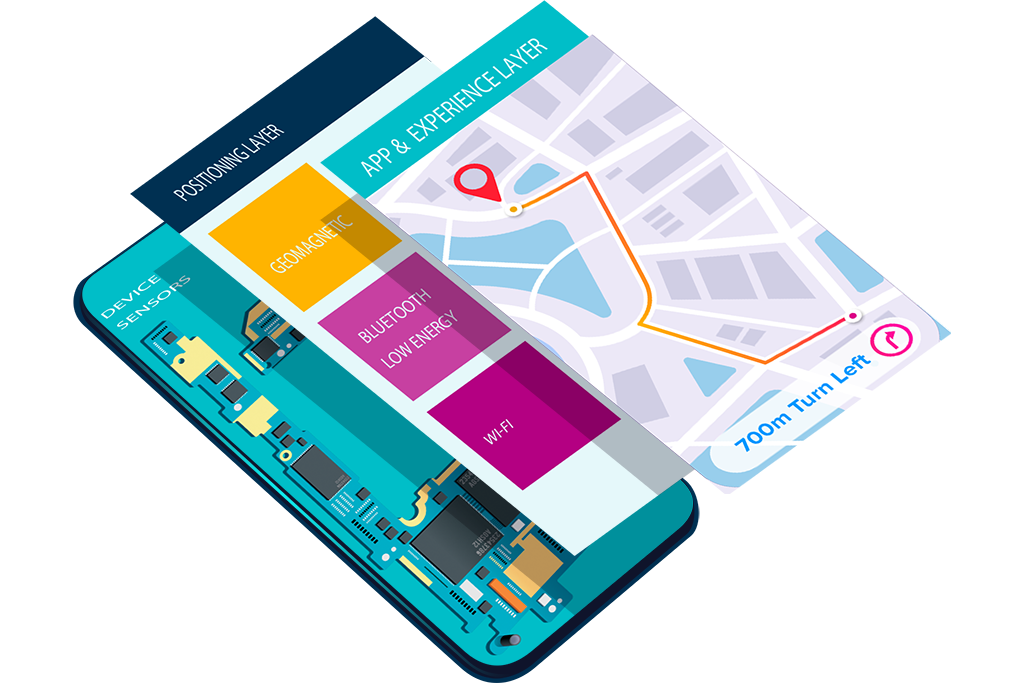What Technology is Best for Indoor Wayfinding?

The University of Michigan defines wayfinding technology as ‘spatial problem solving.’ It is knowing where you are in a building or an environment, knowing where your desired location is, and knowing how to get there from your present location. Wayfinding is a term used not only for technology, also design of architecture, lighting, and static signage all contribute to how people find their way around an area. However many organizations are adopting for digital tools, such as kiosks, tablets or mobile apps, to improve the experience for visitors and staff alike. More venues like shopping malls, airports, metro stations, hospitals, hotels & resorts, stadiums, and entertainment facilities are incorporating indoor wayfinding solutions in addition to Guest WiFi & Experience platforms, aiming to improve guest experiences and enhance digital engagement.
Digital smart wayfinding technology assists visitors in finding their way more quickly, impacting overall business (e.g., timely attendance to appointments, meetings, and flights), and also helps to reduce the need to ask staff for directions. Typically, venues display this information on a digital touchscreen kiosk or a tablet at the reception/information desk. Mobile App plays a great role to deliver turn-by-turn navigation with blue-dot experience, similar to what Google Map and Apple Map provides for outdoors. Mobile Wayfinding falls under the broad term called best indoor positioning system, which has 2 main applications:
- Indoor Wayfinding – using a digital device such as a smart mobile phone to find directions in a building where GPS signal does not work.
- Asset and People Tracking in buildings using Indoor IoT Services such as Bluetooth Low Energy (BLE) Tags or WiFi tags.
This blog text specifically addresses Indoor Mobile Wayfinding (also called Turn-by-turn Navigation, Indoor Navigation, or Indoor GPS). Using a smart mobile phone, visitors can find their way with a Mobile App or Browser App within a building. Indoor Navigation is a need for modern buildings, hospitals, airports, hotels & resorts. Venue operators usually embed a piece of software (Indoor Positioning SDK) within their App to provide this service to their guests and employees
Commonly, 2 technologies are used for Indoor Positioning: WiFi and BLE Beacons. However, a third alternative called the geomagnetic field has emerged, thanks to enhanced mobile device technologies. Nevertheless, no technology perfectly solves indoor positioning needs; each has its advantages and disadvantages over the others.
How Indoor Positioning Works:
Indoor positioning algorithms are deployed in two ways:
- Server-side Positioning– All data from the mobile device is sent to the server, which calculates the position and shares it back with the client’s mobile device to locate the blue dot on the map.
- Client-side Positioning – Positioning algorithms are deployed within the Mobile App. Advantage of this method is that there is less communicated with the server, which might be slightly faster than server-side positioning
Smartphones have many sensors and antennas built-in such as GPS, WiFi, Bluetooth, magnetic sensor (compass), and barometric sensor. For outdoor environments, GPS sensors are used, as seen with Google Maps. To determine a location, the phone needs to receive signals from three satellites to locate a smart device on the map. However, GPS cannot be used indoors due to weak or nonexistent GPS signals within buildings. Therefore, indoor position finding requires equipment such as WiFi, BLE Beacons, or the Earth’s magnetic fields.
Indoor Positioning using WiFi:
WiFi triangulation is one of the oldest technologies used for this purpose. The reason behind is that all public buildings have WiFi, and vendors tried to utilize this technology. Additionally, all mobile devices have WiFi chips. Zone-level positioning can be achieved using WiFi under favorable circumstances, with a well-designed WiFi triangulation setup. However, achieving high precision is not easy, requires hefty investment on WiFi infrastructure.
WiFi is not directly used as a single source by IPERA for indoor positioning. However, it complements the geomagnetic field (Earth’s magnetic field) indoor positioning algorithm that IPERA and its ecosystem partners are developing. WiFi helps detect floors as well as indoor/outdoor transitions. Any WiFi network can be supported in this regard, as long as it communicates with smartphones.
Indoor Positioning using Bluetooth Low Energy (BLE) Beacons:
BLE Beacons are being installed in numerous commercial venues. They provide cost-efficient way to create small to midsize indoor positioning deployments for both iOS and Android. However, beacons have their own issues when it comes to accuracy and scalability. Especially battery-powered BLE Beacons may require regular maintenance and battery replacement every year or so, depending on usage. The majority of small and medium Indoor Wayfinding vendors rely on BLE Beacons. The convergence of BLE and WiFi antennas on Wireless Access Points is a good option when Access Points with built-in BLE Beacons are used for indoor navigation purposes.
Indoor Positioning with Geomagnetic Fields:
Fast development of sensor technology that is embedded in modern smartphones enabled new opportunities for companies like IPERA and its technology partners to utilize the earth’s magnetic field for Indoor Positioning and Mobile Wayfinding. The Earth’s magnetic field strength was measured by Carl Friedrich Gauss in 1832 and has been measured repeatedly since then. Magnetic anomalies inside buildings impact the readings of compass sensors on smart devices. The compass sensor shares this information with the software, allowing the software to learn more about the magnetic field characteristics of that specific building. The more information the software collects, the better it gets familiar with the location, and accuracy or precision gets better. According to a recent study, location accuracy can exceed 97%, meaning that achieving accuracy within 1-3 meters is not a significant challenge with a well-designed algorithm. For the same level of location precision, deploying many BLE Beacons would be necessary. However, accurately detecting floor changes within a building might be challenging using this method. While the barometric sensor helps in determining vertical movement and floor changes, it might also lead to misleading information. In such cases, two simple methods can be applied: 1) placing battery-powered BLE Beacons near each elevator to detect floor changes, or 2) informing users to change floors when around elevator areas, giving visitors and guests the initiative and making it easy from a user experience perspective to change floors with a single click.
Indoor Positioning with Augmented Reality:
AR indoor positioning uses augmented reality (AR) technology to overlay digital information in the real world. This information can include step-by-step directions, arrows, maps, and a course-correcting compass that can help users navigate their surroundings.
There are several different ways to implement AR indoor positioning. One common approach is to deliver incredible immersive experiences to customers. AR indoor wayfinding, guide people through a physical space that is augmented and enhanced with contextual information and content. Visual markers are physical objects that are placed in the venue. The AR device can identify these markers and use them to determine its location easily.
Another approach is to transform your generic ads into AR experiences. Thus, with AR can create interactive campaigns with clickable links directing customers to new deals, events, and more. Advertises can elevate into captivating AR adventures. Campaigns can be crafted to be complete with clickable links guiding customers to exciting new deals, exclusive events, and a world of possibilities.
In this way, it can be delivered location-based AR content and experiences that target the right audience in the right place at the right time, ensuring maximum engagement.





